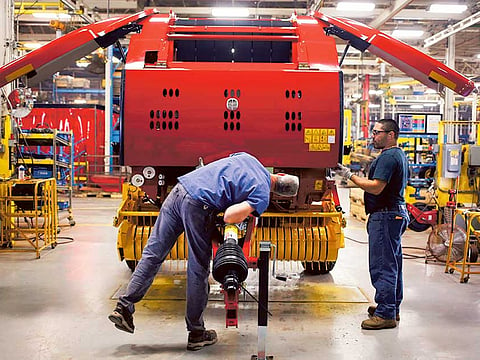US factory data, auto sales improve, construction spending slips
ISM manufacturing index rises to 53.2 in June as new orders rise

WASHINGTON: US factory activity expanded at a healthy pace in June as new orders, output and exports rose, new industry data showed on Friday, providing another sign that US economic growth was regaining its footing after weakness early this year.
Automakers reported higher June sales amid strong demand for pickup trucks and sport utility vehicles, but on an annualised basis, the June industry selling rate came in at 16.66 million units, well below May’s sales pace of 17.45 million.
Ford Motor Co and Fiat Chrysler reported June sales gains of 6.4 per cent and 6.5 per cent, but General Motors, Toyota Motor Corp and Volkswagen all sold fewer vehicles.
Some analysts say that industry sales may have peaked in 2015 at 17.45 million units, but GM chief economist Mustafa Mohatarem still held out hope for another record year.
“Positive economic indicators like historically low interest rates, stable fuel prices, rising wages and near-full employment provide the environment for strong auto sales to continue in the second half of the year,” Mohatarem said in a statement.
But the positive for manufacturing and autos was dampened by a second straight monthly drop in construction spending in May.
The weaker construction data could prompt some economists to trim back their second-quarter growth estimates and could help reinforce the Federal Reserve’s view that there is currently too much uncertainty over global and US growth to raise interest rates in the near term.
“Net-net it is a certainly a bit of a mixed picture, a mixed bag, but I think in terms of direction, what is evidenced here, is that growth momentum has rebounded,” said Millan Mulraine, deputy chief economist at TD Securities in New York.
He added that a major “asterisk” to the improvement is that the data surveys predate Britain’s vote last week to leave the European Union, which has injected a big source of uncertainty to the global growth outlook.
The Institute for Supply Management said its national factory index rose to 53.2 in June, the highest since February last year, from 51.3 in May. A reading above 50 indicates expansion in the manufacturing sector, which accounts for about 12 per cent of the US economy.
The ISM new factory orders index in June showed a reading of 57.0 compared with 55.7 in May, while export orders showed 53.5 versus 52.5. The order backlog index rose to 52.5 from 47.0, while production rose to 54.7 from 52.6.
The employment index rose to 50.4 in June from 49.2 in May, for its first reading over 50 since November.
US stocks rose after the ISM data, and major indexes all closed higher for the fourth day in a row, to recover nearly all of their sharp losses in the wake of the “Brexit” vote. The dollar fell against a basket of currencies as benchmark US Treasury yields fell, with the 30-year bond yield at its lowest since the 1950s.
While the International Monetary Fund anticipates that uncertainty over Britain’s departure from the EU will dampen near-term global growth, it remains unclear how much Brexit might affect US demand.
In addition to its factory index, ISM on Friday released a survey that showed 61 per cent of businesses saw a negligible impact from Britain’s EU vote for the remainder of this year. It showed only six per cent forecasting a negative impact, and there was little difference between manufacturing and non-manufacturing firms.
Manufacturing remains constrained by the lingering effects of the dollar’s surge and the oil price plunge between June 2014 and December 2015. The sector has also been hurt by business efforts to reduce an inventory glut, which has curtailed orders.
CONSTRUCTION SLOWDOWN The Commerce Department said on Friday that May construction spending fell 0.8 per cent after a downwardly revised 2.0 per cent drop in April. The revised April drop was the largest since January 2011.
Economists polled by Reuters had forecast construction spending rising 0.6 per cent after a previously reported April drop of 1.8 per cent. May construction outlays were up 2.8 per cent from a year earlier.
May construction spending was held down by a 2.3 per cent drop in public construction spending. Outlays on state and local construction projects, the largest of the public sector segment, tumbled 3.0 per cent, while federal construction spending rose 7.5 per cent.
Private construction spending fell by 0.3 per cent after a downwardly revised 1.9 per cent fall in April. Outlays on private residential construction were flat, while spending on private nonresidential construction was down 0.7 per cent.
Sign up for the Daily Briefing
Get the latest news and updates straight to your inbox



